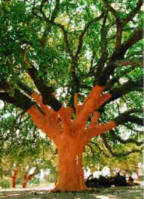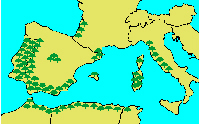|

All photos courtesy of
Cork Supply USA
|
|
the cork cycle
By: Thomas M. Ciesla
Originally published in texaswinetrails.com; February, 2001
Article has been reformatted for online publishing
|
|
|
|
The lifecycle of wine
begins and ends with patience. At the beginning of this cycle is of course
the grape. Vineyard managers and winemakers know that new vines need at least
three to four years before the grapes are suitable for winemaking. As the
vines continue to mature, the grapes improve and produce finer, more complex
wines.
At the end of the wine lifecycle is the
cork, used since the time of ancient Egypt as the last bastion of defense
against the evil oxygen. Unlike the vineyard manager who thinks in
terms of 4 - 5 years to wait for the first harvest, cork growers have to wait
ten times that before they can harvest wine-suitable cork!
|
|

|
Cork is harvested from
the Cork Oak tree, Quercus suber L., which is found predominantly
in the Mediterranean, with Portugal and Spain producing 82% of the world's
raw cork. Italy, France, Morocco, Algeria and Tunisia account for the
remaining18%. The majority of the cork harvest is used for wine stoppers,
with lower quality cork material going into shoes, gaskets, linoleum and
agglomerated products.
|
|
Natural cork has a
unique structure. The bark of the cork tree is made of tiny cells, each a
14-sided polyhedron with intercell spaces filled with oxygen or nitrogen. A
single cubic centimeter of cork contains approximately 40 million of these
cells. This cellular structure allows cork to recover 85% of its initial
volume almost immediately after compression, and 100% within 24 hours. Cork
also has a high coefficient of friction and is almost impermeable to liquids.
|

|
|

|
Cork is harvested in a
steady cycle that promotes healthy growth to the tree over its 200-year
lifetime. Virgin cork is first removed when the tree is 25 years old, then
followed by the harvest of what is called reproduction cork (first cycle)
after another 9-12 years. It is another 9-12 years before wine-suitable cork
can be harvested. In the mature tree, cork bark is cut and harvested in the
form of planks (from the main trunk) or tubes (from branches).
|
|
The cork bark is stacked
and left to age in the forest before being boiled to expand the natural
cellular structure. After the cork has dried to 20% moisture content, it is
hand punched (higher quality cork), or machine punched (lower quality) into
wine bottle cork shapes.
|

|
|

|
Modern washing systems
using a variety of chemicals sanitize the corks against bacterial growth,
with some manufacturers utilizing new technologies such as irradiation as a
final weapon against the potential of TCL growth which results in cork taint.
Corks are then sealed in bags containing inert gases before being shipped to
wineries.
|
|
The 2000 cork harvest
from Spain and Portugal yielded 250,000 tons of cork bark, an increase from
last year, due in part from ideal growing conditions and the approaching high
point in the 9-year production cycle. This is good news for winemakers, since
demand has been rising in the past few years, along with the price of quality
cork stoppers. James Herwatt, vice president and general manager for Cork
Supply USA, said, "As a result of the increased harvest, winemakers can
expect overall cork prices to stabilize."
As cork orchard acreage continues to
expand in Portugal and Spain, the heated battle between cork and synthetic
stoppers rages around the world. Each side accuses the other of libelous
campaigns full of falsehoods to undercut market share. One thing is certain,
claims and counter-claims of one products superiority are likely to continue
for years to come. Members of the cork industry insist the advantages of
their product out-weight the occasional problem. For the time being,
winemakers seeking the classic, higher quality image for their wines will
probably use natural cork stoppers.
Gentlemen, start your cork
screws.........
|
|

